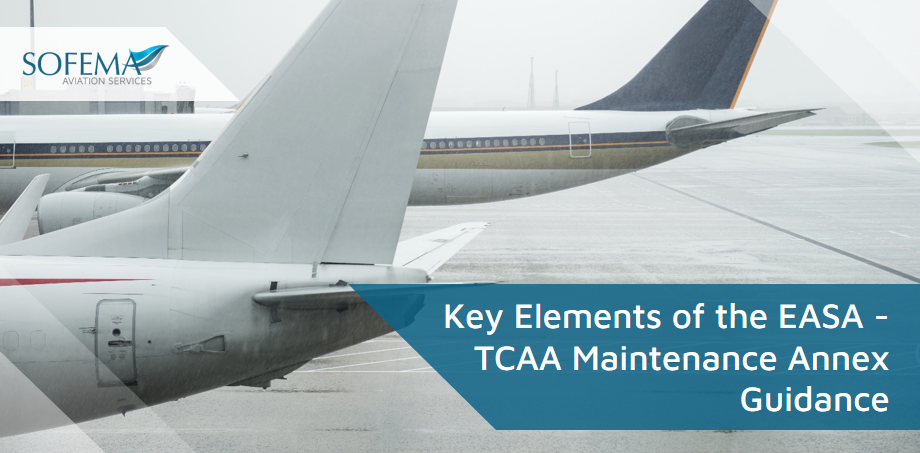Sofema Aviation Services (SAS), www.sassofia.com, considers the key aspects of the Transport Canada—EASA Maintenance Annex Guidance.
Introduction
The Transport Canada Civil Aviation (TCAA) and European Union Aviation Safety Agency (EASA) Maintenance Annex Guidance (MAG) define the processes, standards, and mutual recognition of Approved Maintenance Organizations (AMOs) between the two regions.
- This collaboration supports civil aviation products’ continued airworthiness and safety, facilitating a shared understanding of maintenance practices and certification standards.
Role of TCAA MAG
- The primary role of the TCAA MAG is to facilitate the mutual recognition and standardization of maintenance practices between TCAA and EASA.
- This document is a cornerstone in promoting regulatory coherence and minimizing duplication of efforts for aircraft and components that require maintenance across these two jurisdictions.
Key Roles of the TCAA MAG include:
- Regulatory Harmonization: Aligns maintenance regulations between Canada and the EU, ensuring consistency in aviation safety standards.
- Mutual Recognition of AMOs: Enables AMOs certified by one authority to be recognized by the other without redundant certification processes, streamlining operations for aviation businesses operating in both regions.
- Safety and Compliance Oversight: Provides a framework for ongoing oversight, ensuring that AMOs maintain compliance with applicable regulations.
Annex B
The purpose of Annex B of the Agreement on Civil Aviation Safety between Canada and the European Union. This guidance document establishes the framework by which maintenance organizations in Canada and the EU can mutually recognize each other’s certifications, enabling them to perform maintenance work on aircraft and components that are registered in the other party’s jurisdiction.
The specific purposes are:
- Enhancing Operational Efficiency: Reduces administrative and regulatory burdens on AMOs by allowing maintenance certificates issued by one authority to be recognized by the other.
- Promoting Aviation Safety: Ensures that the maintenance performed under mutual recognition adheres to the highest safety standards applicable in both Canada and the EU.
- Standardizing Procedures: Provides clear procedures for the interaction between Competent Authorities (CAs) in Canada and the EU, ensuring that the regulatory practices are understood and implemented consistently.
Structure of the TCAA MAG
The TCAA MAG is structured to guide AMOs and Competent Authorities through the maintenance certification and oversight process. The guidance is divided into key sections, each of which plays a critical role in ensuring that maintenance work is performed according to international safety standards.
Competent Authority Interaction
- Purpose: Outlines how the TCAA and EASA, along with their respective CAs, interact to implement Annex B of the Agreement. It details the procedures for communication, technical consultations, and resolutions of issues.
- Key Aspects:
- Technical consultations between TCAA and EASA officials to interpret regulations.
- Joint Sectorial Committee on Maintenance (JSCM) for periodic reviews.
- Process for handling revisions to the MAG as aviation regulations evolve.
Cooperation in Quality Assurance and Standardization
- Purpose: Establishes procedures for cooperation between TCAA and EASA in quality assurance and standardization activities.
- Key Aspects:
- Sharing of reports on standardization, quality assurance, and surveillance.
- Involvement of each other’s representatives in audits and inspections.
- Verification of compliance with specific regulatory requirements.
- Sampling inspection systems to ensure compliance with regulatory standards at AMOs.
Approval Process for AMOs
- Purpose: Describes the process for initial and continuation approval of AMOs, ensuring that Canadian and EU maintenance organizations can maintain aircraft and components under the other party’s jurisdiction.
- Key Aspects:
- Submission and review of applications (EASA Form 17 for Canadian AMOs, TCCA Form 24-0093 for EU AMOs).
- Development and approval of the MAG Supplement, which outlines how the AMO will comply with both TCAA and EASA regulations.
- Mutual acceptance of TCCA Form One and EASA Form 1 as proof of maintenance compliance.
- Oversight procedures to ensure ongoing compliance with regulatory standards.
Technical Assistance
- Purpose: Defines the scope of technical assistance that TCAA and EASA provide to each other in terms of monitoring, reporting, investigations, and technical evaluations.
- Key Aspects:
- Collaborative support in investigations related to maintenance deficiencies.
- Both parties monitor ongoing compliance with MAG requirements.
- Joint technical evaluations are necessary to resolve complex regulatory or technical issues.
Safety Management System (SMS) Integration
- Purpose: Introduces Safety Management System (SMS) requirements, reflecting modern aviation safety management practices.
- Key Aspects:
- Implementation of SMS requirements in line with evolving global aviation safety standards.
- Requirement for AMOs to incorporate SMS into their operations, ensuring a systematic approach to managing safety risks.
Next Steps
Follow this link to our Library to find & download related documents for Free.
Sofema Aviation Services (SAS) www.sassofia.com and Sofema Online (SOL) www.sofemaonline provides regulatory training related to Bilateral relationships between EASA – FAA – TCAA and UK CAA. Please see the websites or email team@sassofia.com.
Tags:
SMS Integration, Aircraft Compliance, Transport Canada, AMO Recognition, TCAA, Maintenance Annex Guidance, Aviation Oversight, operational efficiency, EU regulations, aviation standards, Aircraft Maintenance, Bilateral Agreements, Civil Aviation, Aviation Regulations, SAS blogs, Regulatory Compliance, Safety Management System, EASA, Aviation Training, aviation safety




